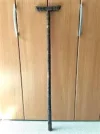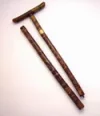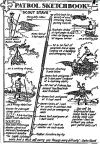Anamiri
Veteran Member
- Time of past OR future Camino
- 2016, 2017, 2019, 2024 Camino Frances
As a fellow kiwi and a convert to 2 poles, I can say they honestly changed my Camino life.
Better for my knees, my back, and I get less tired. And my fingers dont swell up like sausages. I arrive now with the energy to look around and explore. My arms get nice and toned, and I use my sticks as tools along the way, they make washing lines, curtain rails etc
For years I couldn't see the point either, but now I am a complete convert. I wouldn't walk a Camino without them now.
They feel so natural now, I cant understand why it took me so long.
However I see a lot of people using poles incorrectly.
Last weekend I walked the Oxfam Trailwalk in Whakatane. Its a pretty grueling 100km all terrain walk. People fit broadly into two groups. Those who are old enough to know they need to train, and those who say "its only a walk, how hard can it be".
The latter are the people you see broken at various points during the trail. They are also the people who think that buying sticks will compensate for them not training (I am a little harsh here but I have the benefit of overhearing many teams' conversations). This year in particular there were a lot of young people with poles they should just have left at home, for all the good they were doing. Poles that weren't height adjusted. People who carried them just off the ground, dragged behind, stabbed the ground in front, or used them like oars.
Better for my knees, my back, and I get less tired. And my fingers dont swell up like sausages. I arrive now with the energy to look around and explore. My arms get nice and toned, and I use my sticks as tools along the way, they make washing lines, curtain rails etc
For years I couldn't see the point either, but now I am a complete convert. I wouldn't walk a Camino without them now.
They feel so natural now, I cant understand why it took me so long.
However I see a lot of people using poles incorrectly.
Last weekend I walked the Oxfam Trailwalk in Whakatane. Its a pretty grueling 100km all terrain walk. People fit broadly into two groups. Those who are old enough to know they need to train, and those who say "its only a walk, how hard can it be".
The latter are the people you see broken at various points during the trail. They are also the people who think that buying sticks will compensate for them not training (I am a little harsh here but I have the benefit of overhearing many teams' conversations). This year in particular there were a lot of young people with poles they should just have left at home, for all the good they were doing. Poles that weren't height adjusted. People who carried them just off the ground, dragged behind, stabbed the ground in front, or used them like oars.






















